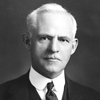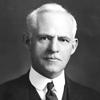Modern Evolution, 1974–Present
From Major Philanthropy to Anchor Institution
As the first, largest and most innovative community trust in America at the time, the Cleveland Foundation entered its second half century as an acknowledged leader in the field of philanthropy. Each of the chief executives who came after James Norton enhanced the organization’s effectiveness, and this process of continuous improvement transformed the Cleveland Foundation into an indispensable partner to others working to effect positive change in the areas of greatest community need.

A satellite photograph of Lake Erie, downtown Cleveland and the Cuyahoga River valley: The foundation has learned to take the long view in helping the community craft fresh responses to persistent urban problems.
 The reversal of downtown Cleveland’s stagnation, symbolized by the redevelopment of the Terminal Tower, is a 60-year-old work in progress in which the foundation has been steadily engaged.
The reversal of downtown Cleveland’s stagnation, symbolized by the redevelopment of the Terminal Tower, is a 60-year-old work in progress in which the foundation has been steadily engaged. Cleveland’s well-financed and -run network of community development organizations targeted this crumbling but historic eight-unit rowhouse in the Central neighborhood for rehabilitation.
Cleveland’s well-financed and -run network of community development organizations targeted this crumbling but historic eight-unit rowhouse in the Central neighborhood for rehabilitation. The East Central Townhomes, after a $1.2 million renovation by Burten, Bell and Carr Development Corporation
The East Central Townhomes, after a $1.2 million renovation by Burten, Bell and Carr Development Corporation Sustaining the excellence of the region’s cultural assets: a summer solstice party at the Cleveland Museum of Art
Sustaining the excellence of the region’s cultural assets: a summer solstice party at the Cleveland Museum of Art Advocating greater reliance on clean energy: a wind farm in northwestern Ohio
Advocating greater reliance on clean energy: a wind farm in northwestern Ohio Linking city kids to life-enriching programs: Duffy Liturgical Dance teaches children to perform and thus preserve songs and dances created by African slaves in America.
Linking city kids to life-enriching programs: Duffy Liturgical Dance teaches children to perform and thus preserve songs and dances created by African slaves in America.How You’ve Been Touched by the Cleveland Foundation
Steady, Astute Investment in Quality of Life Improvements, 1988–2012
$42,589,555
For college scholarships
$126,220,443
For economic development
$175,353,312
For civic affairs and community development
$200,070,763
For arts and culture
$234,002,032
For education
$246,208,248
For social services
$267,045,598
For health
In a region whose core city continues to see its population decline (falling 17 percent to 396,816 between 2000 and 2010) and grow poorer (over the last decade, median income fell from an already low 66 percent of the national average to 59.6 percent), the biggest challenge is, as always, the elimination of societal pain, caused in modern times by an educational system that does not adequately prepare every child to compete in a global knowledge economy and the loss of jobs to globalization. Facing problems this deep and complex, no one person or organization can bring about lasting change alone. But the Cleveland Foundation can usually be found at the table whenever community leaders come together to shape a healthier civic future, fulfilling one or all of its multiple roles as advocate, strategist, convener, catalyst or resource provider.
The explanation of how the Cleveland Foundation evolved from an exemplary grantmaker to one of Greater Cleveland’s anchor institutions begins and ends with the marshaling of expertise and commitment. Norton’s immediate successor, Homer Wadsworth, recognized that the demands of disbursing $8 million annually required a program staff of seasoned men and women with impressive credentials in their respective fields. Soon after his arrival in 1974, he had hired three top-notch program officers to handle cultural affairs, health and education, and social services. Consultants with even more specialized knowledge began to be retained, as needed.
The drive to professionalize the foundation’s operations accelerated during the administration of Steven A. Minter, Wadsworth’s successor. In office from 1984 to 2003, Minter brought in experienced personnel to head new departments dealing with financial management, human resources, information technology, marketing and communications, and asset development. As a result of the increased attention paid to fund-raising and investment performance, annual income available for grantmaking grew from $15 million to $73 million during Minter’s tenure. To ensure the careful and timely review of a mounting number of grant requests, Minter created the position of program associate. (As another means of helping young people gain experience in the philanthropic and nonprofit sectors, the foundation began to develop internships or sponsor interns from other leadership development programs.) Minter also appointed the foundation’s first “fellows,” who helped the community develop and implement comprehensive anti-poverty and economic development strategies.
Under Minter’s successor, Ronald B. Richard, fellows in international relations and advanced energy and the environment led pioneering business attraction and business formation campaigns. To free senior program officers for similarly high-level work, Richard reorganized the foundation’s program associates into a responsive grantmaking team in charge of evaluating all over-the-transom grant requests. In addition to deep knowledge of their fields, hands-on management skills and political smarts became essential qualifications for senior program directors, as they were now expected to help execute board-directed initiatives by convening and collaborating with community partners.
An expectation had been set during Norton’s tenure that the chair of the board of directors would actively partner with the foundation’s CEO to advance programmatic priorities. Changes to the governance structure made during the Minter administration enabled the foundation to better tap the intellects, talents and perspectives of every board member. A streamlining of grantmaking procedures freed trustees from service on two program subcommittees, each of which met quarterly. With their responsibilities redirected toward policy making, board members could now play a primary role in determining the foundation’s strategic priorities.
In 2012, the Cleveland Foundation awarded $91.6 million in grants. The board has committed roughly $20 million annually to advance strategic initiatives in arts organization stabilization, economic transformation, public education reform, neighborhood revitalization and youth development. As an anchor institution, the Cleveland Foundation contributes more than dollars to the public-private partnerships it has convened to transform the region’s greatest challenges into opportunities for advancement. Over the past five decades, the foundation has developed the capacity to drive real innovation. The process begins with research to document on the gravity of problems, includes a thorough investigation of whether other communities have found solutions that might be applicable here and ends with the mobilization of management and financial resources needed to take action. If need be, the foundation is prepared to advocate with state and local officials for changes in public policy that will support new means of educating children, creating jobs, strengthening neighborhoods, enhancing civic assets and promoting social justice.
This is precisely the kind of resourceful, impactful leadership that Frederick Harris Goff expected community trusts to provide when he established the Cleveland Foundation 100 years ago.

